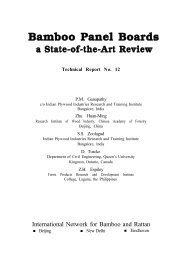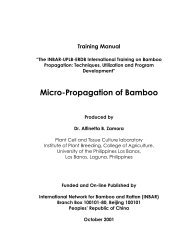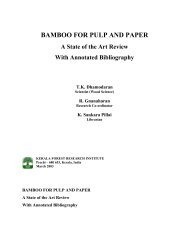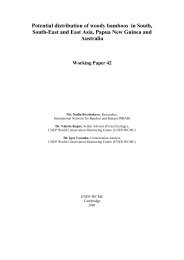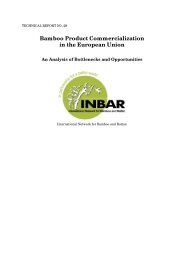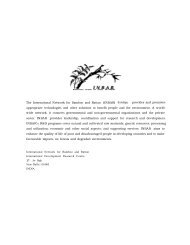The Bamboo and Rattan Sectors in Asia: an Analysis of ... - INBAR
The Bamboo and Rattan Sectors in Asia: an Analysis of ... - INBAR
The Bamboo and Rattan Sectors in Asia: an Analysis of ... - INBAR
You also want an ePaper? Increase the reach of your titles
YUMPU automatically turns print PDFs into web optimized ePapers that Google loves.
<strong>Ratt<strong>an</strong></strong> farmers grow ratt<strong>an</strong> as one <strong>of</strong> the several crops; rice is by far the most<br />
import<strong>an</strong>t food crop, along with b<strong>an</strong><strong>an</strong>as, vegetables, root crops <strong><strong>an</strong>d</strong> rubber. Farmers<br />
pl<strong>an</strong>t ratt<strong>an</strong> seeds along with rice <strong>in</strong> a newly cleared swidden field, or after the rice<br />
is established. Practices vary even with<strong>in</strong> a community. <strong>The</strong> ratt<strong>an</strong> seedl<strong>in</strong>gs are<br />
protected dur<strong>in</strong>g the 1-2 years that the field is used for rice cultivation (after that the<br />
field is left fallow). <strong>The</strong> ratt<strong>an</strong>s used are multi-stemmed, small-diameter varieties that<br />
lend themselves to multiple harvests. This is a good strategy as the establishment<br />
time for ratt<strong>an</strong> is fairly long, but once the rootstock is established stems c<strong>an</strong> be<br />
harvested regularly (typically every 2-4 years). <strong>Ratt<strong>an</strong></strong> provides more th<strong>an</strong> 75% <strong>of</strong><br />
some farmers' cash <strong>in</strong>come. Farmers typically wait for <strong>an</strong> order from a trader, <strong><strong>an</strong>d</strong> <strong>an</strong><br />
adequate price, before harvest<strong>in</strong>g.<br />
<strong>The</strong>re are two levels <strong>of</strong> traders. A few <strong>of</strong> the ratt<strong>an</strong> farmers <strong>in</strong> towns <strong><strong>an</strong>d</strong> villages<br />
<strong>in</strong> the ratt<strong>an</strong>-produc<strong>in</strong>g areas do some trad<strong>in</strong>g. <strong>The</strong>y accept orders from regional<br />
traders <strong><strong>an</strong>d</strong> purchase ratt<strong>an</strong> from other farmers <strong>in</strong> their area to supply the order.<br />
<strong>The</strong>se village traders may have some rudimentary storage facilities. In some cases<br />
they deliver the ratt<strong>an</strong> to the regional traders (or, rarely, to a m<strong>an</strong>ufacturer) or the<br />
regional trader may pick it up from them. <strong>The</strong> village traders may do some sort<strong>in</strong>g.<br />
<strong>The</strong> regional traders tend to have long-term relationship with one or a few<br />
buyers. <strong>The</strong>y also ma<strong>in</strong>ta<strong>in</strong> relationships with a number <strong>of</strong> local ratt<strong>an</strong> traders whom<br />
they c<strong>an</strong> contact to arr<strong>an</strong>ge for cutt<strong>in</strong>g <strong><strong>an</strong>d</strong> collection <strong>of</strong> ratt<strong>an</strong> on order. <strong>The</strong>se traders<br />
normally provide the tr<strong>an</strong>sportation, arr<strong>an</strong>g<strong>in</strong>g for collection from the local traders.<br />
<strong>The</strong>y also frequently provide adv<strong>an</strong>ce money for the orders placed, arr<strong>an</strong>ge the<br />
necessary tr<strong>an</strong>sport permits, <strong><strong>an</strong>d</strong> pay the <strong>of</strong>ficial <strong><strong>an</strong>d</strong> un<strong>of</strong>ficial charges required for<br />
tr<strong>an</strong>sport<strong>in</strong>g the material. Traders have to pay a Forest Product Royalty (IHH),<br />
irrespective <strong>of</strong> the source ---- whether forest or pl<strong>an</strong>tation ---- <strong>of</strong> the ratt<strong>an</strong> they procure.<br />
It is likely that the burden <strong>of</strong> this payment is passed on to the farmers <strong>in</strong> the form<br />
<strong>of</strong> low prices for their ratt<strong>an</strong> produce.<br />
Most <strong>of</strong> the ratt<strong>an</strong> from the gardens <strong>in</strong> Kalim<strong>an</strong>t<strong>an</strong> is used to make lampit. <strong>The</strong><br />
ma<strong>in</strong> market, for over 90% <strong>of</strong> the production, is Jap<strong>an</strong> where it is sold as tatami, the<br />
traditional floor cover<strong>in</strong>g. In addition to the lampit a number <strong>of</strong> other ratt<strong>an</strong>-based<br />
products are m<strong>an</strong>ufactured <strong>in</strong> the area. Most are woven products, <strong>in</strong>clud<strong>in</strong>g various<br />
types <strong>of</strong> mats <strong><strong>an</strong>d</strong> webb<strong>in</strong>g (from peel). Lampit is the most import<strong>an</strong>t product. In<br />
1993, there were 53 lampit enterprises <strong>in</strong> South Kalim<strong>an</strong>t<strong>an</strong> employ<strong>in</strong>g over 12 000<br />
people. Lampit m<strong>an</strong>ufacturers are concentrated <strong>in</strong> two cities <strong>in</strong> South Kalim<strong>an</strong>t<strong>an</strong><br />
---- Amuntai <strong><strong>an</strong>d</strong> B<strong>an</strong>jar Baru. <strong>The</strong>y r<strong>an</strong>ge <strong>in</strong> size from small family-based enterprises,<br />
through <strong><strong>an</strong>d</strong> several with 40-70 workers, up to one with 145 workers. Some do all<br />
process<strong>in</strong>g <strong><strong>an</strong>d</strong> m<strong>an</strong>ufactur<strong>in</strong>g <strong>in</strong>-house, while others perform parts <strong>of</strong> the process<strong>in</strong>g<br />
procedure on a sub-contract basis. <strong>The</strong> sub-contract<strong>in</strong>g is <strong>of</strong>ten undertaken by families,<br />
<strong>in</strong> their homes.<br />
<strong>The</strong> market functions <strong>in</strong> a very top-down way ---- the m<strong>an</strong>ufacturers typically<br />
place orders for raw material through regional traders, who <strong>in</strong> turn place orders with<br />
village traders, who org<strong>an</strong>ize local farmers to supply it. <strong>The</strong> price seems to be<br />
58



